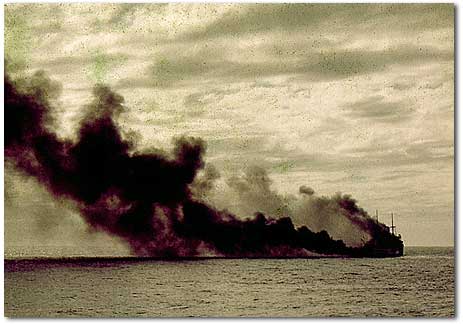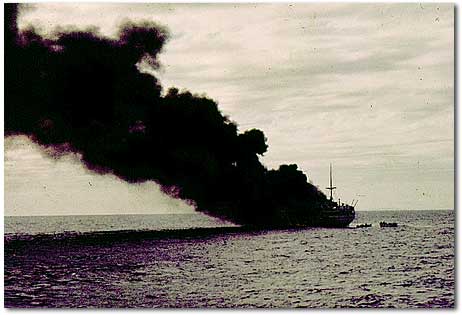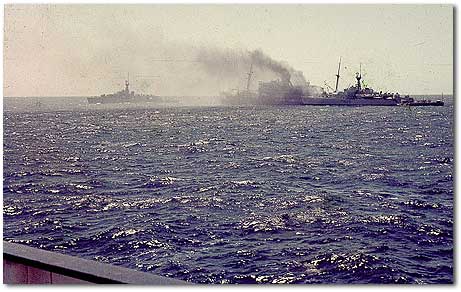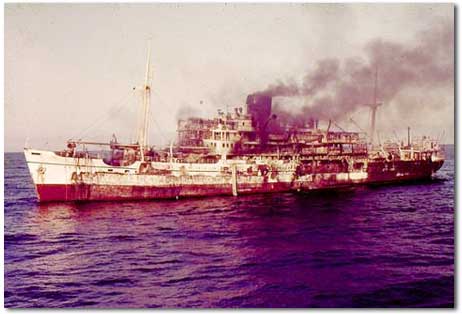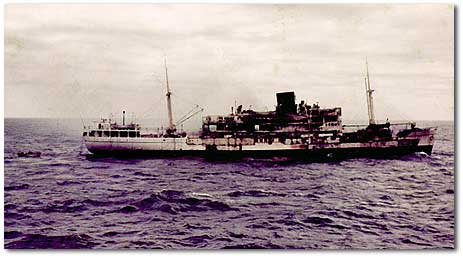FOR ALL THOSE WITH AN INTEREST IN BRITISH INDIA STEAM NAVIGATION (BI)
AT DARA'S WRECK...FORTY YEARS ON
Four decades after the sinking of BI's 4,465 dwt Dara, John Crossman was present as the Dara Wreck buoy off Umm al Qaiwain was lifted for maintenance by the Middle East Navigation Aids Service. This is his account.
ON April 7, 1961, when the BI passenger/cargo liner Dara was discharging cargo and passengers at Dubai, a sudden storm blew up making it necessary for the ship to leave harbour to ride out the gale at sea.
Dara* was one of four BI D-class ships built at yards in the the UK after World War II. Now the ship, which had been delivered 13 years earlier by Barclay, Curle was running BI's successful Bombay-Gulf passenger service.
While returning to port next morning the ship was
shaken by an explosion at 0440, followed by a fire which swept through the ship. Some of the lifeboats were capsized in the ensuing scramble to escape and, in spite of there being several other ships nearby to assist in the rescue, 238 passengers, crew and Dubai shore staff died out of a complement of 819.
The fire was brought under control by naval parties, and the ship was taken in tow, but she sank at 0920 on April 10. Terrorist action was believed to have caused the explosion but nothing could be proved.
Forty years later, shortly after sunrise on the morning of St Valentine's Day 2001, at a position twenty miles north of Dubai and four miles offshore from Umm al Qaiwain, I watched the Middle East Navigation Aids Service (MENAS) light tender Relume
lift on to her deck the yellow and black painted navigation buoy (pictured here on the foredeck) marking the wreck of Dara for cleaning and painting, and to check that the flashing light was in good working order and the buoy's mooring was in good condition.
Relume was making one of her regular rounds of the Arabian Gulf to check, maintain, refurbish and replace some of the hundreds of navigation aids maintained by MENAS to ensure the safety of shipping in these waters.
The depth of water around the Dara wreck is about 100 feet (30.4 m), and with some parts of the wreck only a few feet below the surface it presents a serious danger to shipping in the area where there is much traffic serving the several ports nearby. It is important, therefore, that the buoy to guide shipping clear of this danger is checked regularly and kept in good condition.
On this occasion, apart from a general cleanup and a coat of paint there was nothing that had to be done to the buoy, but part of the mooring chain had worn in excess of permitted limits and had to be replaced, for which some of Relume's old anchor cable was found to be a satisfactory substitute.
It took about an hour to complete the service of the Dara Wreck buoy and for the first part of the process Relume's captain, Captain Nick Dodson, ordered the ship's work-boat to be launched so that I could take photographs from the boat of the buoy being lifted out of the water.
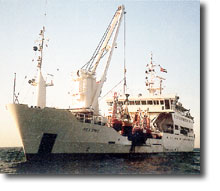
This year's work on the Dara bouy is typical of the maintenance undertaken by Relume (pictured right, handling the Dara buoy) on navaids in the Arabian Gulf. After a thorough check of a buoy's structure, its moorings and its equipment, the refurbished navaid is lifted from the deck, returned to the water and its position checked using MENAS' Gulf-wide differential GPS system.
While Relume goes about her work, Dara rests on the seabed, another example of the great irony of marine tragedy: That the ships that are lost are the ones that survive.
John Crossman, a former P&O main board director, joined the board of MENAS in 1993. The organisation, whose members include P&O, BP Amoco, Caltex, Emirates Oil Company, Mobil, Shell and United Arab Shipping Company, operates more than 500 navigational aids from the coast of Oman to the northern end of the Gulf.
This article is reproduced with kind permision of the editor of Wavelength magazine, in which it first appeared, and the author.
These pictures were taken at the scene from Barpeta, one of the vessels standing by during the incident. They are reproduced from 35mm transparencies with kind permission of Gary Ruaux, who was 3rd Officer in Barpeta. Barpeta was on her maiden voyage from Australia to The Gulf at the time
Rescue operations were led by the landing ship Empire Guillemot (which came under BI management in the month after the Dara incident)
Some of the naval vessels attending.
USS Laffey manoeuvred alongside the wreck to fight fires and check for survivors. While alongside, Dara began listing towards Laffey causing some damage and forcing Laffey to move away.
A fire-fighting party sent by boat continued to fight the fire until noon on April 9, when Laffey was ordered to withdraw.
The fire just about out, a boat approaches Dara's stern *Built in 1948, Dara had a passenger capacity of 1,451 and 5,000 cu ft of refrigerated space. A single Doxford diesel engine gave a trials speed of 15.4 knots. Between them, she and her sisterships, Dumra, Dwarka and Daressa, maintained the famed BI Gulf service from 1946 until 1982, when the only remaining vessel of the quartet, Dwarka, was sold for demolition. She was the last ship in regular service wearing BI livery.
Other history pages: Timeline | Companies | Routes | BI News | Mercantile Empire | BI/P&O Merger document | Gairsoppa & Mantola | Dara wreck | Rohilla disaster | Calabria | Abhona trials | E Africa Shipwrecks | Today in History

